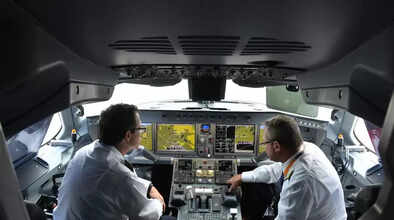Career Tips: What degree is required to become a pilot of a plane like the Dreamliner? How important is experience after training?

Air India Boeing 787 Dreamliner (Flight AI171) crashed on Thursday near Sardar Vallabhbhai Patel International Airport in Ahmedabad, Gujarat. There were 230 passengers and 12 crew members on board this plane. This tragic incident has once again started discussions about pilot training and aviation safety. In this episode, let us try to understand what degree is required to become a plane pilot. What training has to be undergone to obtain a degree? How important is experience? How to get a commercial pilot license. Which institutes provide training to become pilots. How is this training obtained?
Process of becoming a commercial pilot
Becoming a commercial pilot is a long, difficult, and responsible process. It includes several stages of education, training, and experience. According to the guidelines of the Directorate General of Civil Aviation of India (DGCA) and the International Civil Aviation Organization (ICAO), this process is completed in several stages, but to become a pilot, any candidate must have these three eligibility.
How much education is required to become a pilot: To become a commercial pilot, candidates have to obtain at least 50% marks in 12th class (10+2) with Physics, Mathematics, and English. English is mandatory, as it is the global language of aviation. Along with this, the age of the candidate should be at least 17 years.
Fitness is equally important: Before starting training to become a pilot, candidates have to compulsorily submit a class one medical certificate approved by DGCA, which tests vision, hearing ability, heart health, and mental stability. This test is repeated every 6-12 months. Some airlines may require a minimum height (about 5 feet 2 inches) due to cockpit design.
Two types of training have to be undergone: For pilot training, candidates have to undergo two types of training, which include theoretical (ground school) and practical (flight training). Both these trainings last for 2 to 3 years.
Three types of pilot licenses
After the tough training of a pilot, it is not easy for any candidate to get a pilot license. For this, one has to pass the scale of experience. In this episode, any pilot is given licenses in three ways in a phased manner, which includes Private Pilot License (PPL) and Commercial Pilot License (CPL) Airline Transport Pilot License.
Private Pilot License
Private Pilot License can be considered as the first stage. In this, candidates are taught to fly small single-engine aircraft. According to DGCA, it includes a minimum of 40 hours of flying, study of meteorology and navigation. It takes 6-12 months to obtain PPL.
How much experience is required for a commercial pilot
200 hours of flying is required for a commercial license
By obtaining a commercial license, any pilot can fly passenger planes, but this journey is very difficult. For a commercial pilot license, the candidate must have 200 hours of flying experience, which includes multi-engine aircraft training, night flying, and instrument rating (IR) experience. It takes 2 to 3 years to obtain this license. For the license, one has to pass the written, oral and flight tests conducted by DGCA.
Airline Transport Pilot License (ATPL)
The Airline Transport Pilot License is considered the top license of this category, after obtaining which one can become the captain of large aircraft. For this, 1500 hours of flying and multi-crew cooperation (MCC) course are required. It can take 8 to 12 years to obtain ATPL. To fly special planes like Boeing 787, which was involved in the Ahmedabad accident, 4-8 weeks of simulator and on-job training is taken.
Cost and training institutes
The cost of obtaining PPL and CPL in India can be Rs 25-50 lakh, while in foreign schools it can be between Rs 50 lakh to Rs 1 crore. Major flight schools in India include Indira Gandhi Rashtriya Udan Academy (IGRUA), Raebareli and National Flying Training Institute (NFTI), Gondia.
Disclaimer: This content has been sourced and edited from TV9. While we have made modifications for clarity and presentation, the original content belongs to its respective authors and website. We do not claim ownership of the content.

